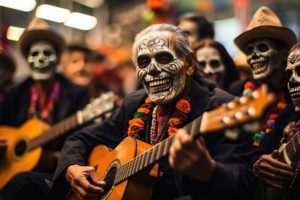All around the world, February is truly the month of the carnival. From the colourful Italian stylings of the Carnevale di Venezia (Carnival of Venice), the monster parades visible in Germany during the Kölner Karneval (Cologne Carnival), and the spectacular grandiosity of the Rio Carnival, it seems like the world can’t wait to thaw the remnants of winter and kick-start the warm renewal of spring. With so many to choose from, there’s one festival in particular that we’d like to talk about – perhaps the most famous of them all. Its location is New Orleans, Louisiana USA; it was famously the ‘milk & honey’ destination for Peter Fonda and Dennis Hopper’s motorcycle-riding hippies in the classic movie Easy Rider; and as of 2018 it will have been celebrated for 319 years. If you translated the title into English, you’d call it ‘Fat Tuesday’, but everybody knows it in the original French: Mardi Gras.
With the first recorded Mardi Gras celebration in New Orleans dating back to spring 1699, the history of the festival is a long and technicoloured one. Originating as an observance of the Catholic faith in the French-colonial portion of America, Mardi Gras’ revelries take place during the two weeks prior to Ash Wednesday, the official beginning of the Christian season of Lent. Historically, as a symbolic juxtaposition to the ascetic 40 days that proceed after Shrove Tuesday, party-goers indulge themselves in rich foods, drinks and spectacles – with at least one formidable parade taking place every day. With the amount of sensational excess taking place during this time, you can easily understand where the ‘Fat Tuesday’ moniker originates from!
It is speculated in folklore that the word ‘carnival’ originated from the Latin phrase ‘carne vale’, or ‘goodbye to meat’ – a reference to the impending fast of Lent. Historically, a carnival like Mardi Gras also signified the temporary inversion of social norms and customs. Transmitted from Ancient Greek celebrations such as Bacchanalias (tribute rituals to the god of wine), Mardi Gras served to alleviate social tensions and help people ‘let off steam’. For instance: during a normal feast it was traditional for those of the highest status (lords, aristocracy, etc) to be served food first, followed by the other diners in their respective social hierarchy to the lowest. However, during a carnival feast the order would be reversed. Part of the reason the celebrations during Mardi Gras became so charged is that it signified the last time people could eat and drink well; using up their remaining stores from the winter, they would seek to voraciously devour the rich food that could not be preserved during the 40-day fast.
The two weeks of Mardi Gras are marked by heated anticipation: during the preceding week, it is estimated that the population of New Orleans increases by more than 50% as attendees begin to assemble (in an official 2010 census, the ordinary population of the city was recorded as 343,829). Modern celebrations include highly decorative and often provocative parades by groups such as the ‘Mystic Krewe of Nyx’ and the ‘Krewe of Muses’. A ‘krewe’ is a group who specifically prepare public displays for the carnival season; social clubs do and always have played a very important role in the festivities. The krewe members are, often without exception, costumed and masked in burlesque fashion throughout the proceedings. Their outfits are meticulously planned, often months in advance, and fitted with the utmost dedication: feathers, make-up, thematic props and every colour under the sun are fair game. However, on the day of Mardi Gras itself (Shrove Tuesday), the general public often decide to get in on the action too. In fact, Louisiana state laws regarding the concealment of one’s identity are actually temporarily suspended, although some public buildings may deny entry to those who refuse to shed their celebratory duds.
The extravagant pageants put on by the krewes aren’t limited to just their eccentric wardrobe: parade floats dominate the city’s streets, their choreographed ambassadors dazzling the audience; large, custom-made ‘doubloons’ – coins minted by each krewe with a unique stamp – are cast into the crowds, as well as the infamous technicolour beads now synonymous with Mardi Gras, and troops of blazing torch-bearers march down the sultry streets of New Orleans. The latter are called flambeau carriers, and before the advent of electrical lighting, they served to illuminate the festival during the hours of darkness. Now, the flambeau carriers practice a special kind of performance art renowned for its unrestrained movements and forms. Some families have even made participation a long-standing tradition, literally carrying on the flame for their ancestors.
Although the party may still be going strong after three centuries, the conclusion of each individual Mardi Gras is as abrupt as the first blossoms of spring it portends. As the final hours approach, the elected ‘King’ and ‘Queen’ of the carnival converge at the New Orleans Municipal Auditorium, where two masked balls are held in their honour. With the stroke of midnight and the arrival of Ash Wednesday, the revelries are officially drawn to an end and the New Orleans police force make an exhibition of clearing the lingering patrons from the city’s famous Bourbon Street. As dawn breaks on the horizon, sanitation workers begin to limber up for the truly hefty task of cleaning the carnival’s debris.







